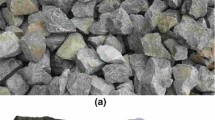Abstract
A simple and fast original method to create irregular particle shapes for the discrete element method using overlapping spheres is described. The effects of its parameters on the resolution of the particle shape are discussed. Overlapping spheres induce a non-uniform density inside the particle leading to incorrect moments of inertia and therefore rotational behaviour. A simple method to reduce the error in the principal moments of inertia which acts on the individual densities of the spheres is also described. The pertinence of the density correction is illustrated by the case of free falling ballast particles forming a heap on a flat surface. In addition to improve behaviour, the correction reduces also computational time. The model is then used to analyse the interaction between ballast and geogrid by simulating pull-out tests. The pulling force results show that the model apprehends better the ballast geogrid interlocking than models with simple representation of the shape of the particles. It points out the importance of modelling accurately the shape of particles in discrete element simulations.
Similar content being viewed by others
Abbreviations
- DEM:
-
Discrete element method
References
Cundall P.A., Strack O.D.L.: A discrete numerical model for granular assemblies. Géotechnique 29(1), 47–65 (1979)
Thomas P.A., Bray J.D.: Capturing nonspherical shape of granular media with disk clusters. J. Geotech. Geoenviron. Eng. 125, 169–178 (1999)
Iwashita K., Oda M.: Rolling resistance at contacts in simulation of shear band development by DEM. J. Eng. Mech. 124, 285–292 (1998)
Iwashita K., Oda M.: Micro-deformation mechanism of shear band process based on modified distinct element method. Powder Technol. 109, 192–205 (2000)
Jiang M.J., Yu H.-S., Harris D.: A novel discrete model for granular material incorporating rolling resistance. Comput. Geotech. 32(5), 340–357 (2005)
Jiang M.J., Leroueil S., Zhu H-H., Yu H.-S., Konrad J.M.: Two-dimensional discrete element theory for rough particles. Int. J. Geomech. 9(1), 20–33 (2009)
Williams J.R., Pentland A.P.: Superquadric and modal dynamics for discrete elements in interactive design. Eng. Comput. 9, 115–127 (1992)
Lin X., Ng T.T.: A three-dimensional discrete element model using arrays of ellipsoids. Géotechnique 47(2), 319–329 (1997)
Mustoe G.G.W., Miyata M.: Material flow analyses of noncircular-shaped granular media using discrete element methods. J. Eng. Mech. 127(10), 1017–1026 (2001)
Cleary P.W.: Large scale industrial DEM modelling. Eng. Comput. 21, 169–204 (2004)
Pournin L., Weber M., Tsukahara M., Ferrez J.-A., Ramaioli M., Liebling Th.M.: Three-dimensional distinct element simulation of spherocylinder crystallization. Granul. Matter 7(2-3), 119–126 (2005)
Hart R., Cundall P.A., Lemos J.: Formulation of a three-dimensional dictinct element model – Part II. Mechanical calculations for motion and interaction of a system composed of many polyhedral blocks. Int. J. Rock Mech. Min. Sci. Geomech. Abstr. 25(3), 117–125 (1988)
Abou-Chakra H., Baxter J., Tüzün U.: Three-dimensional particle shape descriptors for computer simulation of non-spherical particulate assemblies. Adv. Powder Technol. 15(1), 63–77 (2004)
Lee Y., Fang C., Tsou Y.-R., Lu L.-S., Yang C.-T.: A packing algorithm for three-dimensional convex particles. Granul. Matter 11(5), 307–315 (2009)
McDowell G.R., Harireche O.: Discrete element modelling of yielding and normal compression of sand. Géotechnique 52(4), 299–304 (2002)
Thornton C., Liu L.: How do particles break?. Powder Technol. 143(144), 110–116 (2004)
Wang L., Park J., Fu Y.: Representation of real particles for DEM simulation using X-ray tomography. Construct. Build. Mater. 21, 338–346 (2007)
Lu M., McDowell G.R.: The importance of modelling ballast particle shape in DEM. Granul. Matter 9(1–2), 71–82 (2007)
Matsushima, T., Saomoto, H., Matsumoto, M, Toda, K., Yamada, Y.: Discrete element simulation of an assembly of irregularly-shaped grains: quantitative comparison with experiments. In: 16th ASCE Engineering Mechanics Conference, July 16–18, 2003 University of Washington, Seattle (2003)
Price, M., Murariu, V., Morrison, G.: Sphere clump generation and trajectory comparison for real particles. In: Discrete Element Methods 2007 Conference, 27–29 August 2007, Brisbane, Australia (2007)
Ferellec J.-F., McDowell G.R.: A simple method to create complex particle shapes for DEM. Geomech. Geoeng. 3(3), 211–216 (2008)
Ferellec J.-F., McDowell G.R.: Modelling realistic shape and particle inertia in DEM. Géotechnique 60(3), 227–232 (2010)
Selig E.T., Walters J.M.: Track Geotechnology and Substructure Management. Thomas Telford, London (1993)
McDowell, G.R., Harireche, O., Konietzky, H., Brown, S.F., Thom, N.H.: Discrete element modelling of geogrid-reinforced aggregates. In: Proceedings ICE—Geotechnical Engineering, 159 (GE1), pp. 35-48 (2006)
Author information
Authors and Affiliations
Corresponding author
Rights and permissions
About this article
Cite this article
Ferellec, JF., McDowell, G.R. A method to model realistic particle shape and inertia in DEM. Granular Matter 12, 459–467 (2010). https://doi.org/10.1007/s10035-010-0205-8
Received:
Published:
Issue Date:
DOI: https://doi.org/10.1007/s10035-010-0205-8




